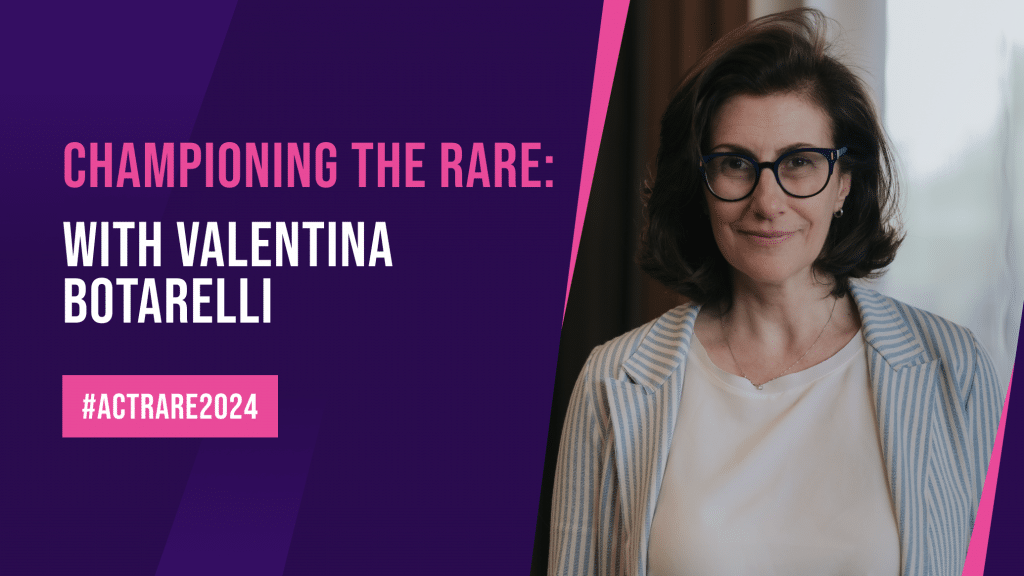Charting the Future: Valentina Bottarelli on Shaping an EU Action Plan for Rare Diseases
April 2024Today, we are joined by Valentina Bottarelli, Public Affairs Director & Head of European and International Advocacy.
As a leading advocate for rare disease policies in the European Union, Valentina brings valuable insights into the challenges and opportunities facing Europeans who live with rare diseases.
With the EU elections on the horizon, our conversation today focuses on the urgent need for an EU action plan on rare diseases.

Q: Vale, could you describe the current landscape of rare diseases in Europe and the primary challenges faced by people living with these conditions?
Certainly. In Europe, rare diseases affect 6% to 8% of the population, roughly 30 million people. Despite these significant numbers, the low prevalence of each specific rare disease often leads to a ‘rarity paradox.’ They suffer from limited visibility, research, and treatment options due to their individual rarity.
Since the 2009 EU Council recommendation, we’ve made significant strides in diagnostics and care. Yet, challenges persist. The 2019 EU Court of Auditors’ report emphasised the need for the EU Commission to reassess and potentially update the 2009 recommendation. The biggest hurdles include unequal access to healthcare and the protracted journeys many patients face to obtain an accurate diagnosis. Furthermore, there’s a considerable unmet need for support services and comprehensive care.
The Rare 2030 foresight study, which we conducted with over 200 experts, further underscored the need for a new policy framework to address these ongoing and emerging challenges.
Q: Given these challenges, why is a cohesive EU action plan for rare diseases so crucial, and what should it encompass?
The evolving landscape of rare diseases, as highlighted by the Rare 2030 study and the EU Court of Auditors’ recommendations, makes an EU action plan more essential than ever. It needs to unify strategies across EU Member States to overcome healthcare fragmentation. This involves standardising approaches to diagnosis, treatment, and research, which will lead to better patient outcomes. The plan should bring together, under a common framework, existing efforts, and it should focus on supporting new ones in areas where there is still work to be done. For example, fostering European-led research in areas like genomic health and precision medicine, enhancing cross-border healthcare collaboration, and ensuring equal access to treatments. It’s also vital that the plan tackles the broader social and economic impacts of rare diseases, including helping patients integrate into society and the workforce.
Q: What specific goals and expectations do you hold for this action plan?
Our primary goal is to establish measurable, tangible objectives to enhance the lives of those with rare diseases. This includes drastically reducing the time to diagnosis, which currently averages around five years, and – by aligning with the internationally established International Rare Diseases Research Consortium (IRDiRC) target – introducing over 1,000 new therapies, particularly for conditions lacking treatment, which is by far the largest majority of them.
We also aim to decrease the overall economic, social, and psychological burden of rare diseases by a third. Additionally, the plan must foster a robust research ecosystem and support digital health innovations, ensuring Europe remains at the forefront of health innovation and patient care.
Q: Lastly, how can policymakers effectively shape the future of rare disease care in the EU?
Policymakers have a crucial role. They must champion the creation and implementation of the new EU action plan, ensuring it is well-funded and seamlessly integrated into broader health policies. They should foster international collaborations for sharing knowledge and best practices.
With the EU elections approaching, it is vital for candidates and officials to prioritise rare diseases, ensuring that the progress made in recent years not only continues but also accelerates.
With rare diseases driving innovation in research and healthcare, a comprehensive EU-wide policy for rare diseases could be the key catalyst for the forthcoming EU Health Union.
As we conclude, we want to call on all current and future EU policymakers and European Parliament candidates to become rare disease champions. Your pledge is crucial in building an inclusive, health-focused future for the EU.
Join us in supporting the 30 million Europeans with rare diseases!
Julien Poulain, Communications Manager
